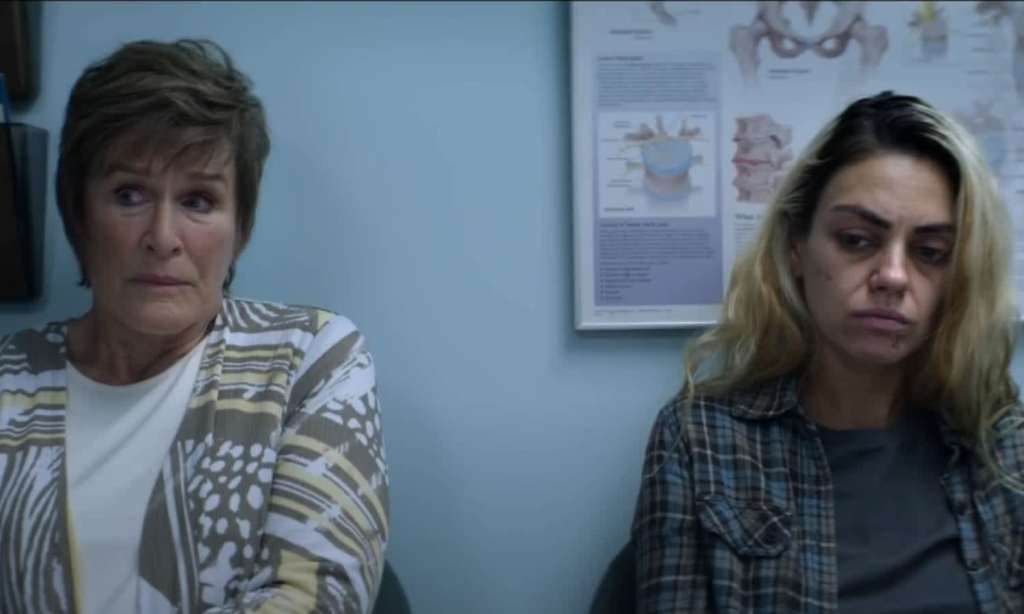**Trigger warning: this article contains references to addiction.
Mila Kunis is known for her comedic roles in films such as Forgetting Sarah Marshall and Bad Moms, not to mention on beloved television series That 70s Show, but the actress also demonstrated she had some serious acting chops with her performance in 2010’s Black Swan.
In what may prove to be her darkest role yet, Kunis will next be seen in the gritty addiction drama Four Good Days, opposite Oscar-winner Glenn Close.
The plot revolves around a woman recovering from heroin, methadone, crack, and Adderall use named Molly (Kunis) who moves back in with her mother (Close) and stepfather as she struggles to abstain. Kunis undergoes a startling transformation in the film, eschewing her usual fresh faced appearance for a downtrodden, sallow-skinned ghost of her former self complete with rotting gums and missing teeth.
The film is based on a 2016 Washington Post article, written by Pulitzer-Prize winning writer Eli Saslow and titled ‘How’s Amanda? A Story of Truth, Lies, and an American Addiction’. It’s a heartbreaking story of a Michigan woman who, like Molly, moves back in with her mother as she fights to survive an addiction to heroin that has destroyed her life.
Hoping that Naltrexone treatment can finally free her of the dependency she has lived with for 11 years, Amanda must avoid using heroin for two weeks before she can receive the experimental drug.
In reality, Amanda’s addiction began when she was prescribed 120 tablets of Vicodin for a minor snowmobiling accident when she was a teenager in high school. In the film, Molly begins her journey of addiction after spraining her knee as a 17-year-old and being given a prescription for OxyContin.
It’s this pernicious cycle that has resulted in the ongoing opioid epidemic America has been battling since the 1990s, when pain treatment plans shifted from a holistic and multi-faceted approach to a “pill for every ill” attitude. This was spurred on by general practitioners who felt pressure to treat more patients in less time and who were lured by the lucrative incentives offered by pharmaceutical companies — such as Purdue — to over prescribe highly addictive painkillers such as OxyContin and Vicodin.
As dependency on synthetic opioids ravaged the nation, people using the drugs soon realised that they could sell their abundance of prescribed pills as party drugs, thereby allowing the medication to infiltrate local youth communities. In fact, according to journalist one study found that 75 percent of those addicted to opioids in the United States began with prescription painkillers given to them by a friend, family member, or dealer.
It wasn’t long before the country was in the grips of a second wave of the epidemic, as people experiencing addiction turned to heroin which was cheaper and worked faster, but was far more lethal. Sadistically, enterprising heroin dealers learned to work the areas around the various “pill mills” that were popping up all over the place, enticing people experiencing withdrawal with bags of black tar heroin — often sold with a discount if they received the promise of a referral.
Since 2019, over 800,000 Americans have lost their lives to opioid addiction, but the its not just a problem our overseas counterparts are facing. According to the National Drug and Alcohol Research Centre, Australia has one of the highest levels of opioid use globally, with almost 15 million opioid prescriptions being dispensed in 2015 alone, and 69 percent of drug-related deaths that same year being a result of a prescription drug overdose.
Although legislative action has been taken to stop the practice of over-prescribing and under-evaluating patients — such as holding pharmaceutical companies accountable for their role in the epidemic (in November 2020 Purdue Pharma pleaded guilty to three criminal charges for their active role in the crisis) — there are still multiple challenges faced by those people experiencing addiction.
Given that one of the crucial factors in combating or avoiding drug dependency lies in human connection, it’s little wonder experts are anxious to see how the isolation brought on by the COVID-19 pandemic, coupled with society’s increasing dependence on social media, and the instant gratification that goes hand in hand with it, could potentially derail efforts to help people overcome addiction.
Four Good Days, which premiered at the Sundance Film Festival in 2020, is a film that perhaps makes an unpleasant truth somewhat palatable. Viewers can watch the film safe in the knowledge that Kunis is, of course, not someone with an addiction and is merely playing a role that allows her to prove she is capable of being more than a quirky love interest or pithy leading lady.
However, audiences should also keep in mind that for millions of people, the trauma of addiction and recovery is not something distilled into 99 minutes, but a lifelong journey from which they may never return.
Four Good Days will be available on Prime Video, iTunes and Google Play from May 21.
If you or someone you know is suffering from addiction, please visit the Alcohol and Drug Foundation for a comprehensive list of resources.
Read more stories from The Latch and subscribe to our email newsletter.







